Do women and men really need different Bibles and Bible studies?
Last week on the Bare Marriage podcast, the wonderful Aimee Byrd joined us and told about her experience in a conservative complementarian church trying to learn more about Scripture and theology.
That conversation was amazing (please listen in if you haven’t!), but I’d like to focus today on one thing that Aimee brought up, because I’ve noticed it too: very different Bibles are marketed to men and women.
1. What’s the effect of having “pretty” Bibles for women?
Ever noticed how Bibles for women are often pink and pretty?
There’s nothing wrong with beauty, but as Aimee said:
The cover itself would function well on something else. But on the Bible, for women, it’s already sentimentalizing God’s Word to us. It’s like saying, “You approach the word in a sentimental way. This is pretty for you.”
But we’re talking about God’s Word here. There’s a lot of ugly in there! It leads us to beauty, but the Bible does not hold back. God does not hold back on the truth of our condition, or on what’s happening in the world. And so to sentimentalize it and put this pretty cover on it–well, that’s really sending a message to women, right? Or what women can handle, of how we’re to even approach God’s Word I feel like.
I agree. I’ve never liked the idea of a “pretty” Bible. As Canadian sociologist Marshall McLuhan said (as a Canadian with multiple sociology degrees, I’m partial to Canadian sociologists): “the medium is the message.” Marketing the Bible as a pretty, fluffy thing for women says something–especially when we don’t do that for men. It says what we expect of how men read the Bible vs. how women do.
2. Why is the content so different in men’s vs. women’s Bibles?
Aimee talked about how she took a look at the women’s and men’s devotional ESV Bibles, and noticed some interesting differences.
Here are the articles in the men’s vs. the women’s Bibles. Notice any differences?
ARTICLES IN WOMEN’S BIBLES:
- The Church and Women at Risk
- Eating Disorders and Other Self-Destructive Behaviors
- Missional Living
- Emotional Health
- Forgiveness
- Healing
- Shame.
ARTICLES IN MEN’S BIBLES:
- Leadership
- A Man’s Inner Life
- Why Regard Self Control as the One Essential Ingredient to Biblical Manhood
- Life in the Local Church
- Calling
- Pornography
- A Man’s Work
As Aimee noted, everything on the side of the woman is either domesticated or having to do with victimhood. Even compare how they handle eating disorders and pornography. For women, eating disorders are called self-destructive. For men pornography is not labelled that way in the title. ‘
Besides this, why isn’t emotional health important for men? Why wouldn’t forgiveness, healing, and shame be important for men as well? Why wouldn’t women want to learn about leadership or life in the local church? Why is there an article called A Man’s Work but not one called A Woman’s Work?
3. Who gets to write in men’s and women’s Bibles?
It’s not just about the content of the articles, either, but who gets to write them.
The woman’s Bible has both male and female authors, Bible teachers, pastors, and that’s great. You’re hearing from all these different voices.
But not so on the men’s devotional Bible. It is only male contributors.
What message do we hear here? When secular, extreme, radical feminists say “The Bible is a patriarchal construction put together by the most powerful men,” we balk, and say, “This is not true.” But then the message that we send in our pretty Bibles and in who gets to the story is the exact same. Our Bibles tell us that women need our own resources to approach the Bible but men do not benefit from the female voice.
I was thinking about this when I remembered something about Rebecca’s Bible as a teenager.
About thirteen years ago I wrote an article on my original blog about how Bibles are marketed, and how they’re not really geared towards studying the Bible, but rather treat the Bible like fluff.
I actually came to some pretty similar conclusions as Aimee, so I asked Connor to dig through the archives, find that article, so we could rerun it here:
In my adult life I have had three Bibles. I started with one I had when I was 16. It was a NKJV study Bible, and I used it constantly. I underlined verses and coloured verses and wrote in the margins. I could find anything in that Bible.
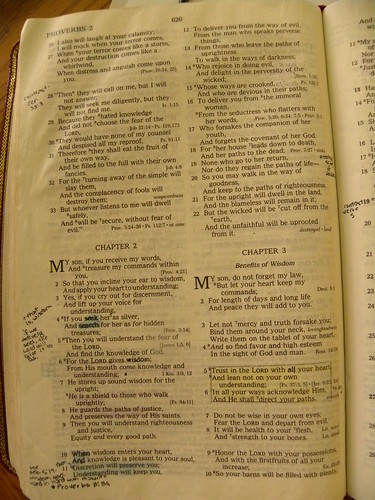
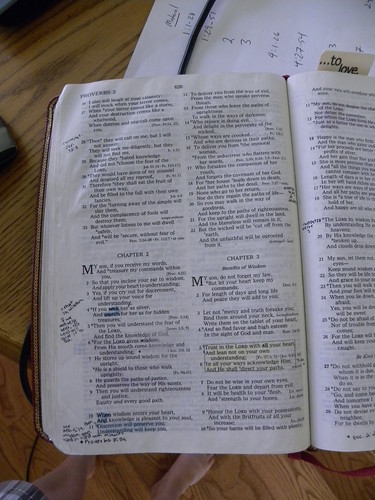
But eventually I just didn’t want NKJV anymore, and I switched to an NIV study Bible. I used that briefly, for about three years, before switching to the Bible I have now, an NRSV which comes–this is the best part, and really why I bought it–with huge margins all around so that you can make lots of notes. I believe in marking up my Bible. It’s how I know what I’ve already read, and what I’ve already thought, and I find my notes useful when I read again.
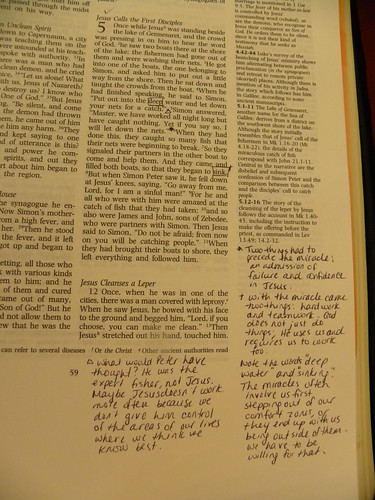
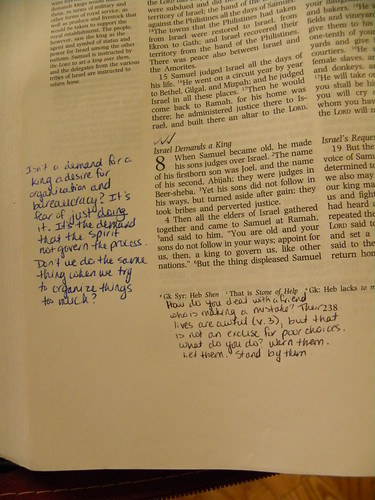
Most people, I find, do only have a few Bibles because we get attached and it’s hard to part with them.
That’s your whole history of your spiritual journey in one book! How could you start fresh? What do you do? Move all your notes over?
And yet, even though we feel that way about Bibles once we’re adults, we don’t expect to feel that way when we’re children or teens. Bibles are marketed with the assumption that kids will buy a new one at each new stage in their lives. They’ll have an easy one with pictures, and then a slightly harder version, and then they’ll go through several different teen Bibles before they reach adulthood.
I think this is done more for the marketing of Bibles than it is for the spiritual health of children.
I do believe in having young children who can read–let’s say 7-9–read from an easier version, like the New Living or the TNIV. But once they’re reading novels, I don’t see why we don’t just let kids graduate to the Bible that they will start using in their spiritual faith. I did at 16, and I could have done so at a younger age. Pick the version that you like to read and memorize from, and buy that for your 10-11 year olds. Or save it until they’re 12 and make it into a big birthday present that’s meaningful.
I was reminded of the importance of this recently when my daughter showed me a teen Bible that she won for free (as in we didn’t pay good money for it). It’s a lovely Bible, pink and brown, that’s very attractive. But what we didn’t bargain for was what came inside of it.
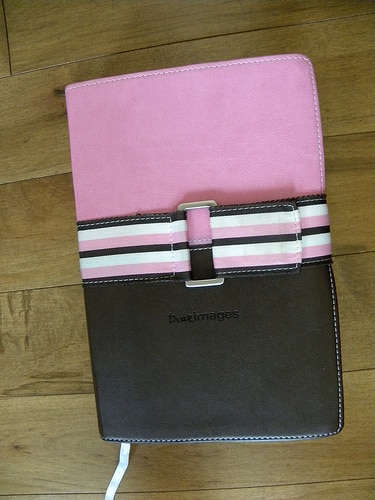
There were quizzes about “My Favourite Date” or “What I Look for in a Boyfriend”. I can’t tell you them all now because in disgust Rebecca ripped them out. Why is a Bible encouraging young teens to think about dating? She thought it was stupid.
But that’s the problem with Bibles marketed to a specific segment of the population. Bibles marketed to teens will include dating quizzes. Bibles marketed to children will include little devotionals or anecdotes about school or about what to do when parents fight and other stuff that really doesn’t belong in a Bible. They’re all done as sidebars, so they’re not part of the text or anything, but they’re still there, staring at you, as you read through Proverbs. Becca tore out all the dating quizzes, but other stuff is still there.
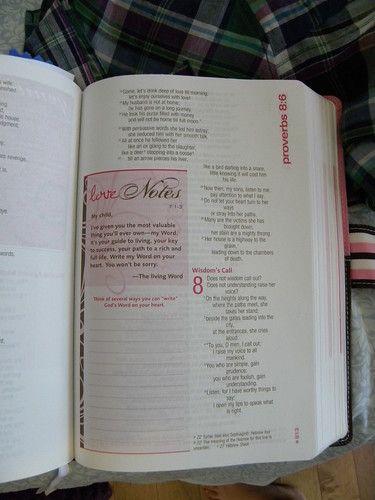
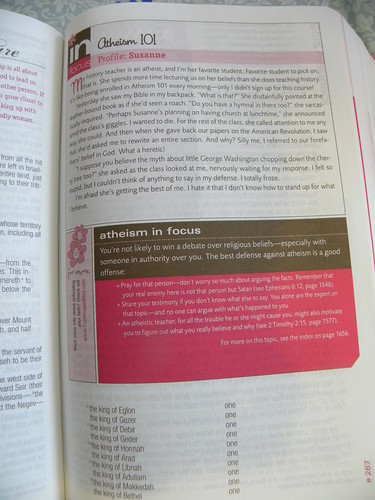
I have no problem with sidebars that list the miracles of Jesus or the parables of Jesus or anything like that. I find such things helpful study aids. But sidebars in any Bible–whether for children or teens or women–that are more quiz based or devotional based I find strange. It’s not that I’m against devotions; it’s just that those sidebars usually give a particular slant to the story or passage that you’re reading, and I’d rather let God’s Holy Spirit talk to me at that time. If I want to read a devotional, I’ll get a separate devotional, thank you very much.
I know that companies just need to make money, and hence they’re marketing Bibles like this. And I do believe that everyone should have their own Bible so that they can make their own notes in it.
But I would just caution you before you buy your next Bible or you or a family member or friend:
What do you want your Bible for? If you just want something to use as a study aid, then you don’t need one specifically for women or teens or kids or fishermen or moms or golfers or anything. You just want a Bible with margins for leaving notes and with the occasional map or chart.
And such a Bible is good regardless of gender, age, class, nationality. It speaks to everyone. After all, that’s what it was written for. Maybe it’s time we got back to that!
P.S. to any Bible companies reading this: Please make more Bibles with big margins for notes. Thank you.
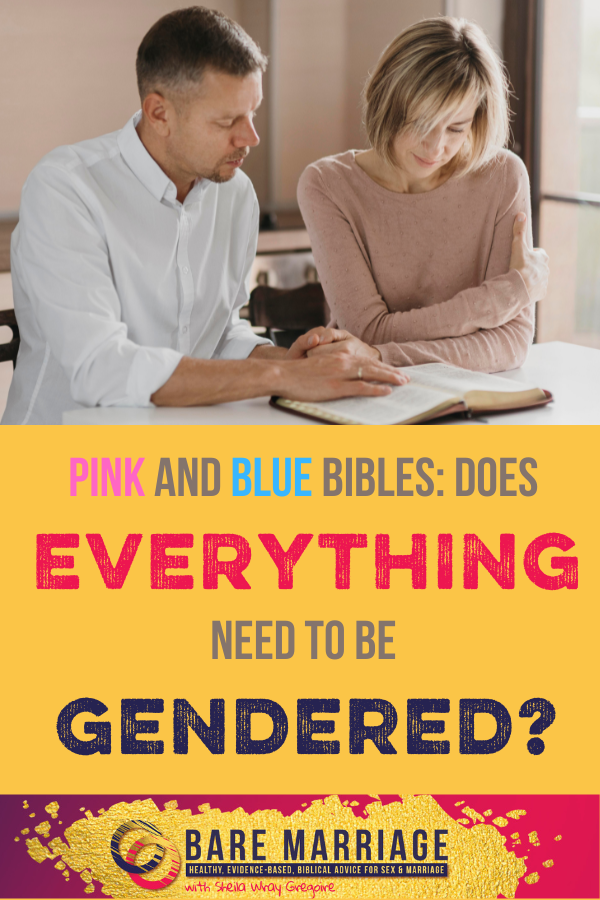
Do you have a women’s Bible/men’s Bible/teen’s Bible? Does it have weird articles in it? What’s the “feel” of the Bible? Let’s talk in the comments!



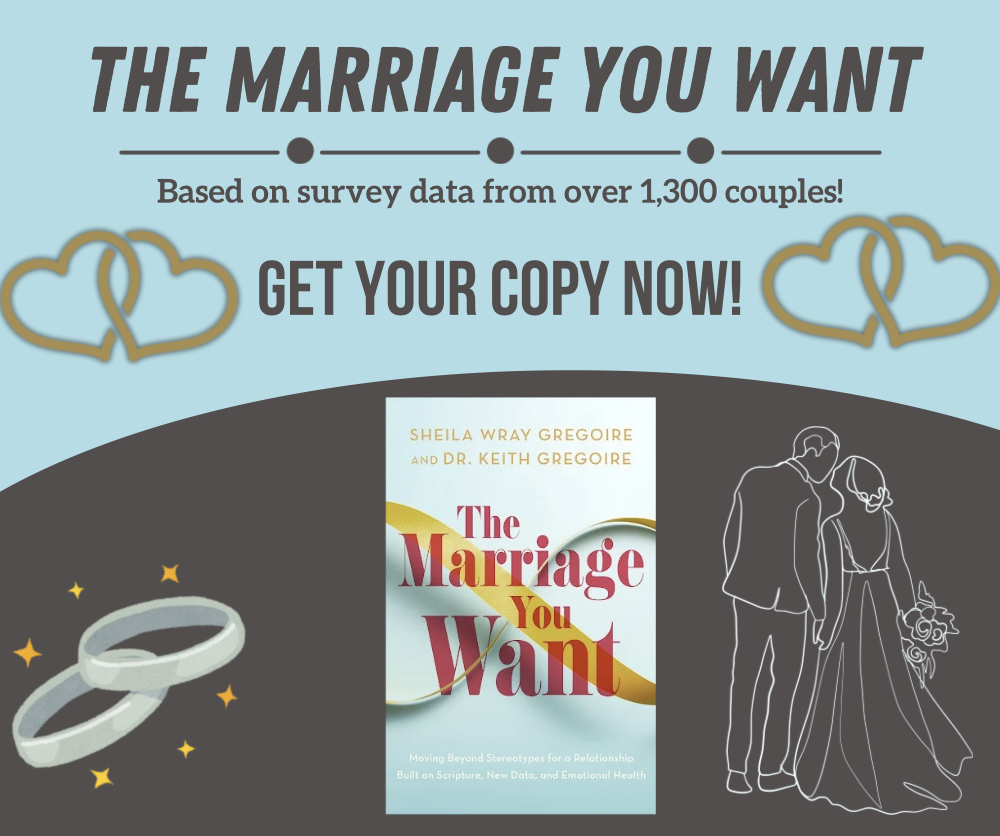
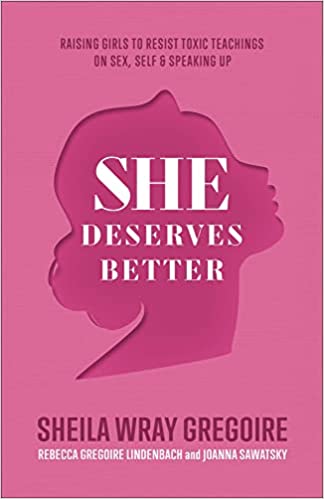
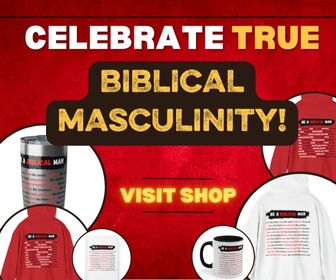


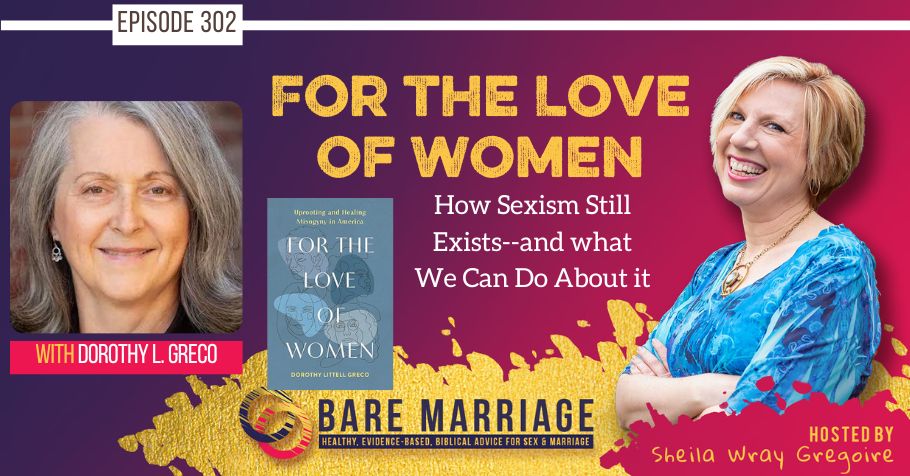

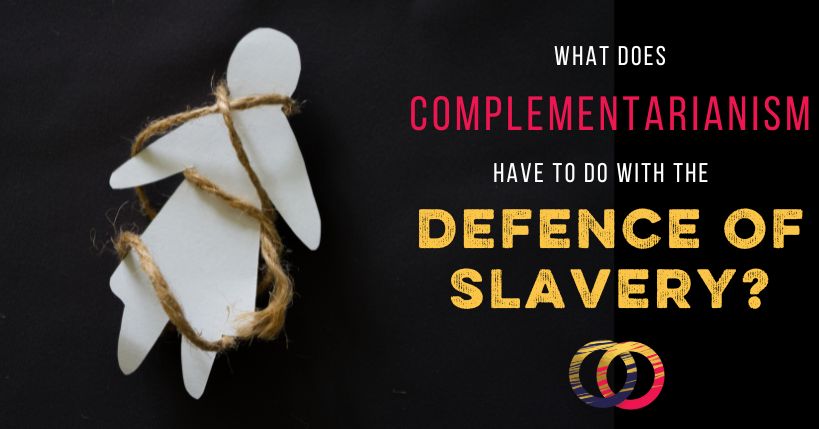




I still have my New American Standard Bible that my father gave to me in 1982. When it started falling apart, I found another one just like it on-line and ordered it. Now I have two. It’s a Holman Master Study Bible. And it is a beast. No fluff there.
It has a section where the gospels are paralleled. and I’m working through that right now.
It’s the one I referred to when I was battling Driscoll’s misinterpretation of the Songs and making it say what it didn’t say.
It’s the one I pointed to when people were praising the ESV for being the best word for word translation (as opposed to a little more paraphrased like the NIV or way more paraphrased like the New Living).
That NAS Master Study Bible was one of the best gifts my father could give me. It helped my bypass all the fluffy female ones and kept me on the path of deeper study with it’s mini-concordance, encyclopedia, and other features that I can’t think of right now.
I have always been sick-to-death with of controlling the narrative and trying to keep women on milk rather than the meat of the Word.
That’s the main thing I don’t like about many devotional bibles: so many inserts and boxes. I’ve flipped through ones were it was almost hard to follow along with the actual text because it was so broken up by “notes”, like at least two huge boxes a page or so (and it was normally the question/quote style notes, not proper reference notes). Although I would like more bibles with beautiful art in them. I finally saw one labeled as illuminated in a book store. The cover was gorgeous, full of gilded symbols. But alas, the inside just had some generic accents rather than more elaborate art. They didn’t even use any gilding inside the book, just matte dark yellow ink! I’m standing there thinking “this isn’t what most people would call illuminated, have you seen properly illuminated pages!?!” I guess it was more for marketing than anything.
One of my pet hates is the way Bibles are marketed by gender and age when the actual text of the Bible is still the same, it’s just the cover and reading notes that change! It’s sensible to get a simpler translation for little kids (I buy all my godchildren the New International Children’s Version for their first birthday so they can use it as they grow up, and then they get a ‘grownup’ Bible translation when they are reading well enough to cope with it) but otherwise, I don’t see the need to ‘dress up’ the Bible for different ages and stages of life.
It makes me mad enough when people try to put men and women into boxes and insist that they all have to like the same thing based on their gender. But it makes me even angrier when people do this with the Bible – the Bible is God’s message to us – how dare people try to manipulate it and decide on our behalf what we are going to learn from it and try to put limitations on what God will say to us through it.
As for my own Bible use, I was given a simple translation for my dedication which I used until I was about 10 or 11. Then I got given an NIV as a Bible club prize – just straight text and footnotes, the only fancy thing in it was a section of photographs of places mentioned in the Bible, which I actually found really helpful as it reminded me that Bible events took place in the real world! When that fell apart in my mid teens, I got another, similar NIV which I still use as my ‘going to church’ Bible. Late teens, I started wanting to read different Bible translations, so I now have 4 or 5 different translations which I alternate for personal study.
Something else that bugs me about the multiplicity of Bibles that are available and the emphasis on the need to keep buying a new one every few years because we are tweens, teens, twenties, young marrieds, young parents, empty nesters, retireds… What about the many people around the world who don’t even have one whole Bible in their own language? Or the people who live in countries where owning a Bible is illegal? Or the people who have risked torture, imprisonment and death just to get hold of one gospel? I wonder how these people would feel if they could see the way so many in the Western world have turned the Bible into some kind of ‘collectible’ – complete with latest ‘must have’ sparkly cover…
My 15 year old daughter recently asked for a new Bible. She wanted one with space to take notes. We looked at several in the store and found one that was just a Bible, no commentary, articles, study notes, etc, it has a wide, lined margin on each page where you could journal or write comments. It had an attractive cover that could be considered gender neutral. I thought it was a good choice and she seems very happy with it.
However, the most disturbing thing about that shopping trip was that i glanced at the clearance Bible table and saw one titled the “Every Man’s Battle Bible.” Oh my, as if we need that content paired with a Bible. Yikes!
Love that you just got her a regular study Bible!
Would be interesting to see how they (EMBB) address the “if your eye causes you to sin, pluck it out” verse! 🙄
I still have my first NIV Bible that my parents got for me when I was a child. It was just the text with some footnotes. I read that until it started to fall apart. I don’t think I’ve bought myself a study Bible per se. Just keep going back for that kind of NIV because I just like having a bit of a concordance and footnotes. I was one of those kids who started reading through the whole Bible when I was in grade 7. And in grade 6, I wrote a paper about heaven based on the last few chapters in Revelation and I still chuckle when I remember my teaching asking me how I knew that and I told her I got it from Revelation (I was in a Christian school). I think it was my fav book at the time.
Anyway, I’m thankful my parents got me that Bible when I was young.
The first text Bibles I got for my girls had pretty covers, but they were basically what I had when I was young on the inside: not study Bibles.
My first bible was a Good News Bible. It was gold with black lettering. I dont know what happenend to it. The first bible I actually recall reading was given to me at a big Lutheran Conference in Atlanta 20 years ago. That was NRSV. It had a read the bible in a year plan in it. I started it and lasted only about 3-4 months. I can still look back and see what I did read. I liked how that read because I couldn’t understand the thees and the thow’s in KJV. Then I had a huge gap of about 11-12 years that I didn’t read the bible at all. Until we moved and my new my Pastor advised me to start reading. So I went back to my NRSV until I started teaching Sunday school. My wife and I use different bibles – hers is NRSV but I switched to NIV on the bible app and we use a CSB mainly because I like the commentary in it. I use NIV from the bible app with a KJV my Mom gave me in the load of books. I like the KJV when I want to het as close to greek interpretation as possible. sometimes I read the same verse from 3 different bibles just to get perspective. I also have a new Oxford the my Mom gave me too. I havent done much with yet but there is commentary in it too. We also use Vernon Mcgee commentary for our Sunday school. My friend, that is good stuff! Whats funny about these bibles with “themes” is it is kind stupid when you think about it. Maybe I should do a Fisherman’s. Bible You know like use this lure and this net cuz Peter and Jesus did 🤣 WTF? Where’s The Fish?
My first bible was also a Good New Bible with red and gold flames on the front cover and lovely, simple line drawings inside.
Apart from the large margins and making notes bit (I don’t like to do that, myself), I quite agree. I don’t want fluffy bits added to my Bibles – historical notes, maybe, but I don’t want anyone’s interpretation poked into my Bible as though it’s authoritative! I do have several Bibles, but have similarly only regularly used a few. I have a Good News from when I was 7 or 8, used until we came across a really odd translation from
Proverbs in it, then an NKJV until I was at university. I bought a newer translation in a metal-case binding then (much more rugged for carting around in my bag!) and then an NLT a few years later… which I’m still using after ~25 years!
I had two Bibles growing up–an NIV with a plain blue cover with my name on it, and an NIV Teen Study Bible. I marked up the biblical text of the Teen Bible alot, but yes, it had weird articles. That one didn’t bother me as much at the time is an NKJV Inspirational study Bible with Max Lucado devotionals all the way through–I pretty much ignore all of them. Yes, it gives Scriptures a slant.
I have a Student Bible (high school/university geared) NIV from the late 80’s (roughly) that I like. It gives an overview before each book about who wrote it, what cultural conditions existed to frame it, etc. which helps me. Unfortunately I took many notes during my time at an SBC church with a narcissistic pastor. I’m thinking of getting a new one so I can start fresh, not have to wade through the bad sermon notes I recorded, and have room for non-patriarchal notes. However, reviewing it helps me see now just how sneaky or biased a lot of his teachings were.
“…you don’t need one specifically for women or teens or kids or fishermen or moms or golfers or anything.”
One thing I like about God’s Word is that He incorporated so many diverse stories- agricultural, fishing, business, family, singles, marrieds, etc. We shouldn’t need a specific theme to get a person to read or understand it- God included a variety of things to connect with most everyone!
A friend buys bibles with wide margins and uses them to create artwork based on what most inspired in that day’s reading. (watercolor, colored pencils, washi tape, ink…) It gives one a creative outlet, helps one think about what you connected most with, and helps solidify what you want to meditate on that day.
I have no qualms with pretty bible covers. I love things that are pretty! I will always reach for something that is visually appealing to me first. When my kids were baptized I purchased regular EHV bibles, I am Lutheran. My daughters is pink with embossed roses on the cover, my sons is a nice distressed brown leather with horse shoes embossed into it. I don’t see anything that makes a bible “fluff” just because the cover is pretty.
Now the gender specific bibles with different sections for girls and boy or men and women are a problem and imo not necessary. We don’t need to shoe horn people into what they need to learn and think due to gender. Men and women’s bible studies should just be group bible study, imagine the learning and conversations that could be had if we let everyone have an equal voice and a turn to speak!
If someone wants a Bible with a particular colour cover, that’s fine by me – what I don’t like is when pink is marketed as being a ‘girl’s Bible’ and blue is marketed as being a ‘boy’s Bible’ – some girls actually prefer blue and some boys prefer pink. (Given the choice between your childrens’ Bibles, I’d prefer your son’s Bible cover!)
But it’s the internal content that is more problematic – every time I’ve looked at ‘women’s’ Bibles, the notes they have in them are just so fluffy and lightweight. There’s something wrong when men are encouraged to grapple with deep issues and women are given light, sugary devotionals – usually based on emotions or looks!
Trivia: blue used to be considered feminine and pink was masculine.
https://www.businessinsider.com/pink-used-to-be-boys-colour-and-blue-girls-heres-why-that-changed-2017-10?op=1
We gave all our kids a real Bible when they learned to read. Since we are in Israel our kids get the original Bible in Hebrew for the OT and the NT is modern Hebrew translated from the Greek. In Israel’s secular schools children start studying the Torah in its original language in 2nd grade (it’s language study and history and cultural heritage for us) and there is a ceremony when they receive their first Bible. We homeschool but we do of course teach the Bible to our kids and they read the original text even though it is old language and difficult (especially prophets and poetic books). It’s hard finding bibles here though that have room for notes. A few years ago a modern translation came out for kids/teens to make reading the bible easier for personal study.
Hi Lydia. Been a minute since I have seen you! Hope all is well…
Yes, all is well. We had a baby and I am stretched in new ways homeschooling the 4 older kids, entering teenage years as parents and a surprise baby thrown in the mix.
In order to make it I must be very careful with my screen time. I often read the blog, but stay clear of the comments most of the time because I get sucked in…
Fair – good to see you and happy surprise baby! We had one of those 13 years ago. He’s a piece of work. Stay well stop in again soon.
I find it odd that bibles for teen girls have quizzes about dating because of all the purity cultures that dating is bad and you shouldn’t date unless its the person you marry. Several years ago I got a women’s study Bible that had profiles of all the women of the Bible and lessons we could learn from them. However I was troubled by gender specific advice about how women should behave based on their gender which is more culture based than biblical. In a section called “complementarian vs egalitarian” the author claimed that comp was biblical and legal was worldly, er sinful. Then another section claimed that God’s highest calling for women is motherhood which I cannot find a Bible verse to back up that statement. Recently, I trashed that Bible. Thankfully, I already own several bibles.
Now that some garbage Laura. Glad you chucked it.
Me too, Phil! I liked reading the profiles of the women of the Bible, but that was basically it.
Sounds like my recent experience with a women’s ESV study Bible. I bought it because I’d seen Marg Mowzkco say on her blog that it was an accurate translation (when it comes to women in Scripture!). Nothing wrong with the actual Scripture, but the Bible itself had a lot of inserts, asides, and devotional sections that were HEAVILY complementarian. The instant I saw an insert that talked about how “God ordained men to be over women,” I sent the Bible back to Amazon. I instead bought a TNIV (another women’s Bible) that still has the fluffy stuff, but nowhere near as bad. The only thing I’ve seen in it that I disagree with is an insert saying men and women can’t be friends once a woman is married. Calling horse puckey on that one.
Does it actually say that in those words?
I like a pretty Bible, personally … but the ones I’ve had have either just had a pretty cover with normal Bible text inside, or my current journalling one with massive margins and some articles about how to creatively meditate on God’s word throughout. But the one I loved most was my teenage New Living Bible, which, yes, had articles, but they were on a variety of topics including faith, spiritual warfare etc., and dating relationships, and stuff like that, hardly featured. Sure, they were a little bit hackneyed in their attempts to appeal to teenagers, but they weren’t cringy or unnecessarily gendered. My other most heavily used version is, in fact, my Message Bible, though, so I don’t know what that says about my Bible -reading stamina!
Have you ever heard Tim Mackie (one of the guys behind the Bible project YouTube channel) talk about ‘the Veggie Tales effect’? Essentially people hearing sanitised kids’ versions of Bible stories in Sunday school (and/or literally from Veggie Tales) and then growing up and still thinking those are stories for kids that they have nothing more to learn from.
Not the same as what you’re saying here, but it struck me as a similar idea. The ways we try to make the Bible ‘relevant’ and end up just making it smaller, instead of just letting it speak.
(And by the way, I’m a different Tim. Not just plugging myself!)
No plug Tim lol. Very Glad thank you. – funny thing – two -three weeks ago my 13 year old decided to start watching Veggie Tales on you tube. He watched an entire season and then goes to school and talks about it and the kids playfully bust him (not bullying). Last week he did a science project on Thomas the Train and then proceeded to watch 5 seasons…and talk about it as school. I think its funny because my wife loves her “baby” who is not such a baby any more but he still plays matchboxes and watches younger kid stuff sometimes and doesnt care what others think. Sanitized? Hardly lol. However, he is a Jesus lover and he even stayed back in his Sunday school class this year because he likes his teacher (and the guy cooks for his class every Sunday) but my son has become an assistant and even teaches a class once in a while with assistance of course…mist be the veggie tales and Thomas the Train lol. Appreciate you telling us you are the real Tim 😬
Haha, thanks. That is a cool story!
I came here to find this article, because I thought I remembered reading it a while back. I am in the market for a new Bible and I was considering the NKJV, The Woman’s Study Bible, Leathersoft, Blue, Red Letter, Full-Color Edition: Receiving God’s Truth for Balance, Hope, and Transformation from publisher Thomas Nelson. But in the previews, it shows on pg. 6, “Theological Foundations for Headship.”
No thanks!!! I’ll be staying far away from that, thank you!!!
Do you have any “safe” Bibles or Bible publishers you recommend? I’m looking for an NKJV version, preferably.
My favorite bibles have all been gender-neutral. I had a women’s study bible at some point, but lost it along the way and never missed it. A lot of the sidebar stuff either felt preachy or fluffy. My first bible was a student bible (not the student study bible that came later) and it was a great starter Bible with a lot of background information that helped me understand what I was reading for the first time.
So I am burning the midnight oil and after all this discussion, I had this wild thought. I am making a new themed bible.
It is called: THE JESUS BIBLE
Reading this article made me think about the times when a Lecturn during Mass would do “voices” while reading from the Bible. So distracting! Just read it without the dramatization, please!
“BUT I WOULD JUST CAUTION YOU BEFORE YOU BUY YOUR NEXT BIBLE OR YOU OR A FAMILY MEMBER OR FRIEND:”
Was the first “or” supposed to be a “for”?
My current study Bible is the generic ESV study bible — not my preferred translation, with the things I’m learning about its very male-centric creation process, but it gets me by. However, I also enjoy just *reading* from an edition I have that has no chapter/verse markings or footnotes — just the book title and the text (divided into standard English paragraphs and sentences, I’m not THAT masochistic XD). Sadly, it has very (very!) narrow margins and makes it nearly impossible to annotate.
However, when it finally becomes available, I very much want to be able to get a copy of the CBE translation. (Center for Biblical Equality, publishers of such fine works as the Priscilla Papers academic journal and more.)
The only thing I wanted to say from this article and the podcast is I think it is fine to have different colors of Bible’s. I do understand what you and the guest were saying regarding what is inside these Bibles; articles.
I gave my new stepmother a beautiful purple “Women of Faith” Bible back around the early 2000’s. I chose it because it was pretty and I knew she loved purple. I have no idea what was inside in regards to additional articles. However, she became a believer a few years later from reading that beautiful purple Bible. She then went on to buy a “serious” bible that was brown leather without all the inside fluff. So, I agree and yet I disagree. You never know how God will use a fluffy pretty bible to draw someone to Him.
When I buy my kids Bibles, we never buy anything with commentary. We usually start out with one with a few pictures and buy a black one when they’re nearing teen years. I also have never had one with commentary. I would, however, enjoy one with really good maps. I love the maps section. (and dictionary and concordance!)